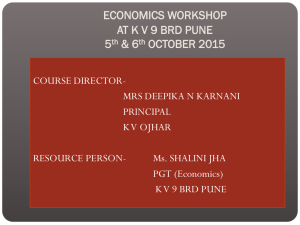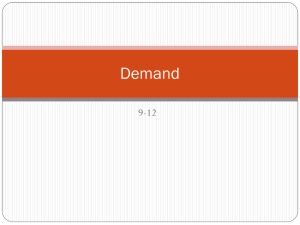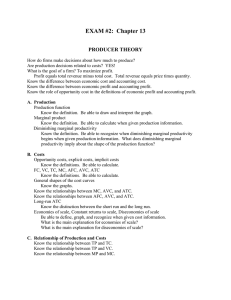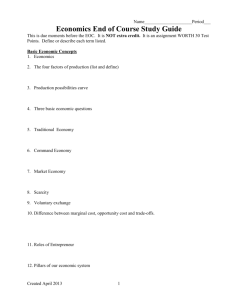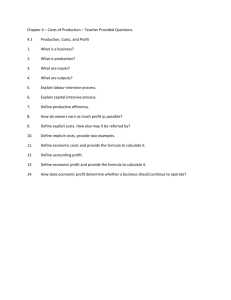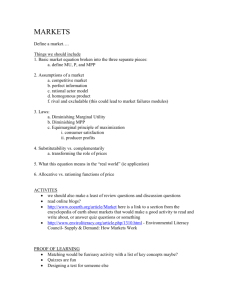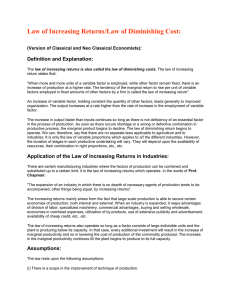Lesson Plan
advertisement
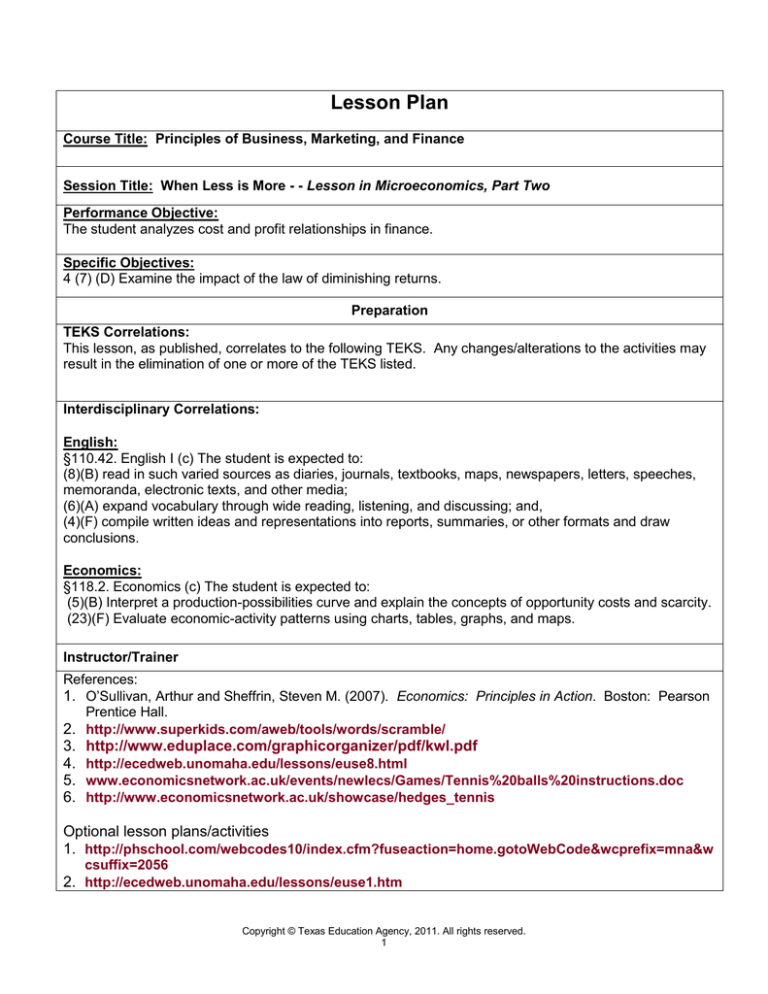
Lesson Plan Course Title: Principles of Business, Marketing, and Finance Session Title: When Less is More - - Lesson in Microeconomics, Part Two Performance Objective: The student analyzes cost and profit relationships in finance. Specific Objectives: 4 (7) (D) Examine the impact of the law of diminishing returns. Preparation TEKS Correlations: This lesson, as published, correlates to the following TEKS. Any changes/alterations to the activities may result in the elimination of one or more of the TEKS listed. Interdisciplinary Correlations: English: §110.42. English I (c) The student is expected to: (8)(B) read in such varied sources as diaries, journals, textbooks, maps, newspapers, letters, speeches, memoranda, electronic texts, and other media; (6)(A) expand vocabulary through wide reading, listening, and discussing; and, (4)(F) compile written ideas and representations into reports, summaries, or other formats and draw conclusions. Economics: §118.2. Economics (c) The student is expected to: (5)(B) Interpret a production-possibilities curve and explain the concepts of opportunity costs and scarcity. (23)(F) Evaluate economic-activity patterns using charts, tables, graphs, and maps. Instructor/Trainer References: 1. O’Sullivan, Arthur and Sheffrin, Steven M. (2007). Economics: Principles in Action. Boston: Pearson Prentice Hall. 2. http://www.superkids.com/aweb/tools/words/scramble/ 3. 4. 5. 6. http://www.eduplace.com/graphicorganizer/pdf/kwl.pdf http://ecedweb.unomaha.edu/lessons/euse8.html www.economicsnetwork.ac.uk/events/newlecs/Games/Tennis%20balls%20instructions.doc http://www.economicsnetwork.ac.uk/showcase/hedges_tennis Optional lesson plans/activities 1. http://phschool.com/webcodes10/index.cfm?fuseaction=home.gotoWebCode&wcprefix=mna&w csuffix=2056 2. http://ecedweb.unomaha.edu/lessons/euse1.htm Copyright © Texas Education Agency, 2011. All rights reserved. 1 3. http://ecedweb.unomaha.edu/lessons/euse5.html Instructional Aids: 1. Optional – Overhead, SmartBoard, Internet, ELMO (if available and where applicable) Materials Needed: 1. Textbook 2. Internet 3. Copies of handouts Teacher Preparation: Instructors should review content from textbook and websites as well as lesson plan addendums prior to class. Learner Preparation: Learners will review vocabulary terms the night before class and read Section 2 Costs of Production from Economics in Action the night before class. Lesson Plan Vocabulary: Marginal Product of Labor The change in output from hiring one more worker Increasing Marginal Returns A level of production in which the marginal product of labor increases as the number of workers increases Diminishing Marginal Returns A level of production in which product of labor decreases as the number of workers increases Fixed Costs A cost that does not change, no matter how much of a good is produced Variable Costs Costs that rise or fall depending on the quantity produced Total Costs Fixed costs and variable costs added together Marginal Costs The additional cost of producing one more unit Marginal Revenue The additional income from selling one more unit of a good Operating Cost The cost of operating a facility such as a store or facility Copyright © Texas Education Agency, 2011. All rights reserved. 2 Introduction (LSI Quadrant I): At what point is it not advantageous to employ one more person? That is the question that the law of diminishing returns answers. Corporations that produce and sell products hire numerous employees to serve in the manufacturing process. However, there is a point at which management understands that hiring one additional person is not cost effective; in fact, hiring that person negatively impacts profit margin. Today, we will embark on a two-part series that will help us to better understand this economic law. Outline Outline (LSI Quadrant II): Instructors can use the PowerPoint presentation, slides, handouts, and note pages to support and reinforce the following outline. MI I. See Multiple Intelligences (MI) key below. Outline Application – Guided Practice A. Students communicate the concept of law of diminishing returns and related vocabulary. B. Students explore the meaning of diminishing return through visual and kinesthetic measures. II. Application – Independent Practice A. Students demonstrate comprehension of student expectation by applying information from guided practice. B. Students complete an oral, informal assessment based on their documented research. I. Notes to Instructor Application – Guided Practice A. Instructor leads class in a discussion of productivity through the following steps. 1. Review the vocabulary words above using Word Scrambler Law of Diminishing Returns, an exercise primarily created from superkids.com and saved as a Microsoft Word document. 2. Complete a K-W-L chart regarding the students’ understanding and wonderings about the law of diminishing returns (see Eduplace website for example). 3. Discuss Cost of Production, Section 2, from textbook to ensure basic understanding. a. Carefully review Figure 5.6. b. Carefully review 5.9. 4. Complete activities that will provide perspective on terms in today’s lesson: a. b. http://ecedweb.unomaha.e du/lessons/euse8.html (fixed versus variable cost) Math Practice, page 114 (textbook) Copyright © Texas Education Agency, 2011. All rights reserved. 3 5. Discuss what was clarified from the K-W-L chart. 6. Ask students to collaboratively give their best definition to the terms documented in the word scramble under YOUR BEST DEFINITION. a. Students present responses to the class. b. Class develops best response. B. Instructor allows students to explore content; activities appeal to kinesthetic learners. 1. Distribute “The Tennis Ball/Flowerpot Game” Word document a. Website for Word document: www.economicsnetwork.ac.uk/ events/newlecs/Games/Tennis %20balls%20instructions.doc b. Additional website for further clarification/extensions/vid eo: http://www.economicsnet work.ac.uk/showcase/he dges_tennis 2. Divide class into 2 teams (groups). a. Complete directions on page 1 of the document referred to above in 1a. b. Use one person per team to record the number of balls placed into the second bucket during each production cycle (30 seconds = production cycle) similar to Figure 5.6 in textbook. 1) Record output per cycle in the file entitled Tennis Ball Spreadsheet on either GROUP 1 – SPREADSHEET or GROUP 2 Copyright © Texas Education Agency, 2011. All rights reserved. 4 3. 4. SPREADSHEET. 2) Calculate and record marginal product of labor. 3) Discuss results. a) Sections in red, column B and cells N4, O4, P4, and Q4, can be altered to change table’s results [teacher should consider and make most appropriate change(s) BEFORE implementing activity]. b) Focus on columns A, B, and C to examine marginal product of labor – production, only. c) Next, review D, E, F, G, and H to discuss the cost perspective of diminishing returns. d) Then, examine I and J to discuss the revenue perspective of diminishing returns. e) Finally, focus on K and L to discuss gross profit. Students individually document answers to questions listed in Discussion after the game from the same Word document. Students share answers with the class; instructor moderates discussion. Copyright © Texas Education Agency, 2011. All rights reserved. 5 a. II. Summary I. Summary Review Questions A. Students will answer review questions Evaluation I. Evaluation A. Students answer assessment to evaluate understanding of class content. Extension/Enrichment I. Extension/Enrichment A. Identify addition questions to ask in order to ensure understanding. B. Students experience diminishing returns through a field trip. C. Students interview experts in manufacturing. Optional: Use SmartBoard or ELMO Application – Independent Practice A. Instructor directs each student to create a visual representation of his/her respective group’s results. 1. Focus on law of diminishing returns with respect to productivity, cost, and/or revenue. a. Option 1: Use charts/graphs in Microsoft Word, Excel or PowerPoint b. Option 2: Use graph paper to plot results for math reinforcement. c. Option 3: Create flowchart that represents productivity process. B. Instructor directs students to present results to members of the class (post results for part 2 of lesson). I. Summary Review Questions A. Ask review questions found on page 7 (see Summary) I. Evaluation A. Instructor directs students to complete Microsoft Word Assessment Activity – Cost of Production Quiz. a. Second page of document reveals answer key. b. Students may use word scramble activity to remind themselves of terms. I. Extension/Enrichment A. See After the Task questions at B. http://www.bized.co.uk/educators/16 19/economics/firms/activity/dimretur ns.htm. Challenge students to develop and document another example to test the law of diminishing return and teach Copyright © Texas Education Agency, 2011. All rights reserved. 6 other students from school. C. Organize a field trip to tour a local plant that produces goods through assembly line methods and talk to the Operations manager. D. Invite a factory manager to be a class speaker and allow students to ask him questions about the manufacturing process/diminishing returns. Copy and paste Multiple Intelligences Graphic in appropriate place in left column. Verbal Linguistic Logical Mathematical Visual Spatial Musical Rhythmic Bodily Kinestheti c IntraPersonal InterPersonal Naturalist Existentialist Application Guided Practice (LSI Quadrant III): I. Application – Guided Practice B. Instructor leads class in a discussion of productivity through the following steps. 1. Review the vocabulary words above using Word Scrambler - Law of Diminishing Returns, an exercise primarily created from superkids.com and saved as a Microsoft Word document. 2. Complete a K-W-L chart regarding the students’ understanding and wonderings about the law of diminishing returns (see Eduplace website for example). 3. Discuss Cost of Production, Section 2, from textbook to ensure basic understanding. a. Carefully review Figure 5.6. b. Carefully review 5.9. 4. Complete activities that will provide perspective on terms in today’s lesson: a. http://ecedweb.unomaha.edu/lessons/euse8.html (fixed versus variable cost) b. Math Practice, page 114 (textbook) 5. Discuss what was clarified from the K-W-L chart. 6. Ask students to collaboratively give their best definition to the terms documented in the word scramble under YOUR BEST DEFINITION. a. Students present responses to the class. b. Class develops best response. C. Instructor allows students to explore content; activities appeal to kinesthetic learners. 1. Distribute “The Tennis Ball/Flowerpot Game” Word document a. Website for Word document: www.economicsnetwork.ac.uk/events/newlecs/Games/Tennis%20balls%20instruct ions.doc Copyright © Texas Education Agency, 2011. All rights reserved. 7 b. 2. 3. 4. Additional website for further clarification/extensions/video: http://www.economicsnetwork.ac.uk/showcase/hedges_tennis Divide class into 2 teams (groups). a. Complete directions on page 1 of the document referred to above in 1a. b. Use one person per team to record the number of balls placed into the second bucket during each production cycle (30 seconds = production cycle) similar to Figure 5.6 in textbook. 1) Record output per cycle in the file entitled Tennis Ball Spreadsheet on either GROUP 1 – SPREADSHEET or GROUP 2 - SPREADSHEET. 2) Calculate and record marginal product of labor. 3) Discuss results. a) Sections in red, column B and cells N4, O4, P4, and Q4, can be altered to change table’s results [teacher should consider and make most appropriate change(s) BEFORE implementing activity]. b) Focus on columns A, B, and C to examine marginal product of labor – production, only. c) Next, review D, E, F, G, and H to discuss the cost perspective of diminishing returns. d) Then, examine I and J to discuss the revenue perspective of diminishing returns. e) Finally, focus on K and L to discuss gross profit. Students individually document answers to questions listed in Discussion after the game from the same Word document. Students share answers with the class; instructor moderates discussion. a. Optional: Use SmartBoard or ELMO Independent Practice (LSI Quadrant III): Application – Independent Practice A. Instructor directs each student to create a visual representation of his/her respective group’s results. 1. Focus on law of diminishing returns with respect to productivity, cost, and/or revenue. a. Option 1: Use charts/graphs in Microsoft Word, Excel or PowerPoint b. Option 2: Use graph paper to plot results for math reinforcement. c. Option 3: Create flowchart that represents productivity process. B. Instructor directs students to present results to members of the class (post results for part 2 of lesson). II. Summary Review (LSI Quadrants I and IV): • • Question: When is a producer’s profits maximized? Answer: It is when marginal cost equals marginal revenue. • • Question: A cost that does not change and is not affected by the number of goods produced. Answer: Fixed cost Copyright © Texas Education Agency, 2011. All rights reserved. 8 • Question: What is the additional income from selling one more unit of good, sometimes equal to price, • called? Answer: Marginal revenue • • Question: What action will eventually cause diminishing returns? Answer: Employing additional labor when capital remains constant. • Question: Why are some employees considered variable costs while others are considered fixed costs? • Answer: Answers may vary. Some employees are paid salaries – a constant, predictable amount that does not change from period to period. Those who are considered variable costs are paid wages; their schedules can be modified based on the needs of the organization, especially as it relates to the production process. Evaluation Informal Assessment (LSI Quadrant III): Evaluate answers to independent practice. Address issues raised in independent practice. Formal Assessment (LSI Quadrant III, IV): I. Evaluation A. Instructor directs students to complete Microsoft Word Assessment Activity – Cost of Production Quiz. 1. Second page of document reveals answer key. 2. Students may use word scramble activity to remind themselves of terms. Extension/Enrichment (LSI Quadrant IV): I. Extension/Enrichment A. See After the Task questions at http://www.bized.co.uk/educators/1619/economics/firms/activity/dimreturns.htm. B. Challenge students to develop and document another example to test the law of diminishing return and teach other students from school. C. Organize a field trip to tour a local plant that produces goods through assembly line methods and talk to the Operations manager. D. Invite a factory manager to be a class speaker and allow students to ask him questions about the manufacturing process/diminishing returns. Copyright © Texas Education Agency, 2011. All rights reserved. 9 NAME _____________________________________________ WRITING EVALUATION CATEGORY 20 18 16 Introduction (topic sentence) The topic sentence is an excellent introduction to the paragraph. It tells the main idea and gives the big picture The topic sentence is a good introduction to the paragraph. It may too broad or have a detail included. Sequencing (Organization) Details are placed in a logical order and the way they are presented effectively keeps the interest of the reader. Ideas Writer has an excellent grasp of the topic. Student uses his/her voice to express thoughts vividly. Details are placed in a logical order, but the way in which they are presented/introduced sometimes makes the writing less interesting. Writer has a good grasp of the Writer knows the subject but does subject. Student uses his/her voice not use his/her voice as much as at times to express thoughts. possible to express thoughts. Writer makes no errors in grade level appropriate capitalization or punctuation. Writer makes a couple of errors of Writer makes a few errors of grade Writer makes many errors of grade grade level appropriate level appropriate capitalization level appropriate capitalization capitalization and/or punctuation. and/or punctuation. and/or punctuation. Grammar & Spelling (Conventions) Capitalization & Punctuation (Conventions) The topic sentence somewhat introduces the paragraph. It does not introduce the paragraph very well and it includes too many details. Some details are not in a logical or expected order, and this distracts the reader. 14 The topic sentence does not introduce the paragraph. Many details are not in a logical or expected order. There is little sense that the writing is organized. Writer uses just the facts to relay thoughts. There is not much of the student's own personality in the writing. Writer makes no errors in Writer makes a couple of errors in Writer makes several errors in Writer makes many errors in grammar or spelling that are grade grammar or spelling that are grade grammar or spelling that are grade grammar or spelling that are grade level appropriate. level appropriate. level appropriate. level appropriate. TOTAL Copyright © Texas Education Agency, 2011. All rights reserved. POINTS AWARDED LAW OF DIMINISHING RETURNS Units of Labor 0 Total Marginal Product Product 0 - Fixed Cost Variable Variable Cost Cost (Labor) (Product) Total Cost Marginal Cost Total Revenue Marginal Revenue 150.00 - - 150.00 - - - Profit (Total Revenue Total Cost) (150.00) 1 0 150.00 7.25 - 157.25 7.25 - - (157.25) 2 0 150.00 14.50 - 164.50 7.25 - - (164.50) 3 0 150.00 21.75 - 171.75 7.25 - - (171.75) 4 0 150.00 29.00 - 179.00 7.25 - - (179.00) 5 0 150.00 36.25 - 186.25 7.25 - - (186.25) 6 0 150.00 43.50 - 193.50 7.25 - - (193.50) 7 0 150.00 50.75 - 200.75 7.25 - - (200.75) 8 0 150.00 58.00 - 208.00 7.25 - - (208.00) 9 0 150.00 65.25 - 215.25 7.25 - - (215.25) 10 0 150.00 72.50 - 222.50 7.25 - - (222.50) 11 0 150.00 79.75 - 229.75 7.25 - - (229.75) 12 0 150.00 87.00 - 237.00 7.25 - - (237.00) 13 0 150.00 94.25 - 244.25 7.25 - - (244.25) 14 0 150.00 101.50 - 251.50 7.25 - - (251.50) 15 0 150.00 108.75 - 258.75 7.25 - - (258.75) Copyright © Texas Education Agency, 2011. All rights reserved. Explanations Fixed cost equals capital (buckets). Evaluate the impact of fixed cost by changing the amount in N4. Variable cost for labor can be changed. Change the wage by entering the amount in cell O4. Variable cost for product (tennis balls) can be changed. Change the cost by entering the amount in cell P4. Market price for product (tennis balls) can be changed. Change the price by entering the amount in cell Q4. Copyright © Texas Education Agency, 2011. All rights reserved.

